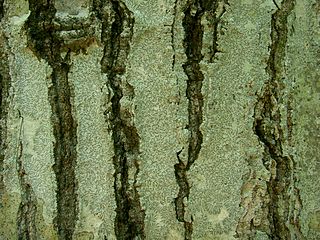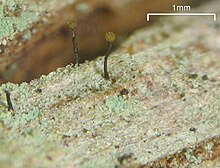
The Leotiomycetes are a class of ascomycete fungi. Many of them cause serious plant diseases.

The Arthoniaceae are a family of lichenized, lichenicolous and saprobic fungi in the order Arthoniales. The Arthoniaceae is the largest family of Arthoniales, with around 800 species. Most species in Arthoniaceae belong in Arthonia which is the largest genus with 500 species. The second and third largest genus is Arthothelium with 80 species, and Cryptothecia with 60 species.

The Sphaerophoraceae are a family of lichen-forming fungi in the order Lecanorales. Species of this family have a widespread distribution, especially in southern temperate regions, with particular diversity in cool temperate rainforests and highly oceanic areas of both hemispheres.

The Ostropomycetidae are a subclass of mostly lichen-forming fungi in the class Lecanoromycetes. It contains nine orders and 37 families.

The Pertusariales are an order of fungi in the class Lecanoromycetes, comprising 8 families, 31 genera, and over 600 species, many of which form lichens. This diverse group is characterized by complex taxonomic history and ongoing phylogenetic revisions. Originally proposed by Maurice Choisy in 1949 and later formally published by the lichenologists David L. Hawksworth and Ove Eriksson in 1986, Pertusariales has undergone significant reclassification due to molecular phylogenetics studies. The order includes well-known genera such as Pertusaria and Ochrolechia, as well as families like Megasporaceae and Icmadophilaceae.

The Gomphillaceae are a family of lichen-forming fungi in the order Graphidales. Species in this family are found mostly in tropical regions. The family underwent a major molecular phylogenetics-led reorganisation in 2023, in which 17 genera were recognised and formally established as new or reinstated.

Verrucariales is an order of ascomycetous fungi within the subclass Chaetothyriomycetidae of the class Eurotiomycetes. Although most of the Verrucariales are lichenised, the family Sarcopyreniaceae consists of 11 species of lichenicolous (lichen-dwelling) fungi.

The Mycocaliciaceae are a family of fungi in the order Mycocaliciales, comprising seven genera and approximately 90 species. Originally proposed in 1970 by Alexander Schmidt, the family is characterised by immersed thalli, stalked brown or black ascomata, and small cylindrical asci that release ascospores without forming a mazaedium. Molecular phylogenetic studies have placed Mycocaliciaceae within the class Eurotiomycetes and led to the inclusion of taxa formerly classified in the Sphinctrinaceae. The family has a fossil record dating back at least 50 million years, with several specimens discovered in Baltic and Bitterfeld amber. Mycocaliciaceae genera include Chaenothecopsis, Mycocalicium, and Phaeocalicium, which exhibit a range of ecological roles from saprobic to parasitic relationships with their substrates.

Acolium is a genus of lichenized fungi in the family Caliciaceae. The genus has a widespread distribution and contains six species. These lichens are found on bark and wood, occasionally on rocks, or growing on other lichens.

Tylophoron is a genus of lichen-forming fungi in the family Arthoniaceae. It comprises seven species of crustose lichens, most of which occur in tropical regions.
Stromatella bermudana is a saxicolous (rock-dwelling) crustose lichen. It is the only species in Stromatella, a monotypic fungal genus in the family Lichinaceae.

Fuscideaceae is a family of fungi that form symbiotic] relationships with algae to create lichens. These lichens typically have a crust-like appearance and are found worldwide, though they are most common in temperate regions. The family includes five genera and about 55 species, which primarily grow on tree bark, rocks, or occasionally on wood or leaves. Fuscideaceae lichens are characterised by their reproductive structures, cup-like formations called apothecia, which can vary in colour from red to dark brown or black. The family has undergone several changes in its classification over the years, with recent genetic studies placing it within the order Umbilicariales. Fuscideaceae lichens produce various chemical compounds, some of which are unique to this family, and these chemicals are often used to help identify different species.

The Caliciaceae are a family of mostly lichen-forming fungi belonging to the class Lecanoromycetes in the division Ascomycota. Although the family has had its classification changed several times throughout its taxonomic history, the use of modern molecular phylogenetic methods have helped to establish its current placement in the order Caliciales. Caliciaceae contains 39 genera and about 670 species. The largest genus is Buellia, with around 300 species; there are more than a dozen genera that contain only a single species.

Pseudothelomma is a genus of crustose pin lichens in the family Caliciaceae. It currently contains two species. The genus was circumscribed in 2016 by lichenologists Maria Prieto and Mats Wedin. The generic name Pseudothelomma refers to its resemblance to the genus Thelomma, where the two species used to be classified. Both species grow on dry exposed wood, particularly fence posts.
Sagiolechiaceae is a small family of lichen-forming fungi in the order Ostropales. It contains two genera, Rhexophiale, and Sagiolechia, the type genus.
Austroparmeliella is a genus of lichen-forming fungi in the family Pannariaceae. It consists of five species, all of which are found in the Southern Hemisphere.
Meridianelia is a fungal genus in the family Elixiaceae. It consists of the single species Meridianelia maccarthyana, a corticolous (bark-dwelling), crustose lichen. This lichen forms greyish-white, crust-like growths on tree bark in subalpine woodlands of Tasmania, Australia. Discovered in 2003 and scientifically described in 2009, Meridianelia is classified in the small fungal family Elixiaceae based on its genetic and structural characteristics. The genus is notable for its unique reproductive structures and its apparent rarity, having been found in only a few locations despite growing in a relatively common type of forest.

Callome is a fungal genus in the family Collemataceae. It consists of the single species Callome multipartita, a saxicolous (rock-dwelling), crustose lichen found in Northern Africa, Europe, and North America.
Nebularia is a small genus of lichen-forming fungi in the family Pannariaceae. It comprises two species, both of which are found in the Andes.

Paracollema is a small genus of lichen-forming fungi in the family Collemataceae. It comprises two species of jelly lichens, characterised by their small size, gelatinous nature when wet, and distinctive reproductive structures. The genus was proposed in 2013 and later validated in 2017. Paracollema lichens form small, leafy thalli up to 1 cm in diameter, with dark olive green to brownish colouration. They are distinguished from related genera by their very small asci and spores. Both known species are primarily epiphytic and have a limited distribution in southern Europe and northern Africa, typically found in Mediterranean or semi-arid climates.















